Abstract
OBJECTIVE: The authors' objective was to identify factors associated with candidemia and candidemia-related death among adult liver transplant recipients. SUMMARY BACKGROUND DATA: Invasive candidiasis is the most common severe fungal infection occurring after liver transplantation and is associated with high morbidity and mortality rates. Although candidemia is not always found during invasive candidiasis, it has been considered as an indicator of invasive candidiasis in immunocompromised patients. METHODS: A time-matched case-control study of 26 patients with candidemia, which was defined as the isolation of Candida from at least one blood culture, and 52 control patients without candidemia was reported. Two control patients were matched with each case patient regarding time of transplantation and duration of follow-up. RESULTS: Between December 1985 and December 1992, candidemia developed in 1.4% of adult liver transplant recipients a median of 25 days after transplantation (range, 2-1690 days). The overall mortality rate among patients with candidemia was 81%, and 71% of these deaths were related to candidemia. Conditional logistic regression analysis was used to identify factors associated with candidemia, which were 1) hyperglycemia treated with insulin up to 2 weeks before candidemia (odds ratio [OR], 16.15; p = 0.002), and 2) exposure to more than three different intravenous antibiotics before development of candidemia (OR, 11.15; p = 0.005). The variables predictive of death related to candidemia were abdominal surgery performed up to 1 week before candidemia (relative risk [RR], 7.25; p = 0.02), high white blood cell count (RR, 1.10; p = 0.01), lower platelet count (RR, 0.99; p = 0.02), and elevated AST with candidemia (RR, 1.001; p = 0.01). CONCLUSIONS: Hyperglycemia that requires insulin and exposure to more than three antibiotics are the factors associated with the development of candidemia in liver transplant recipients. When candidemia develops shortly after abdominal surgery and in patients with elevated AST, high white blood cell count, or low platelet count, it is associated with a high mortality rate.
Full text
PDF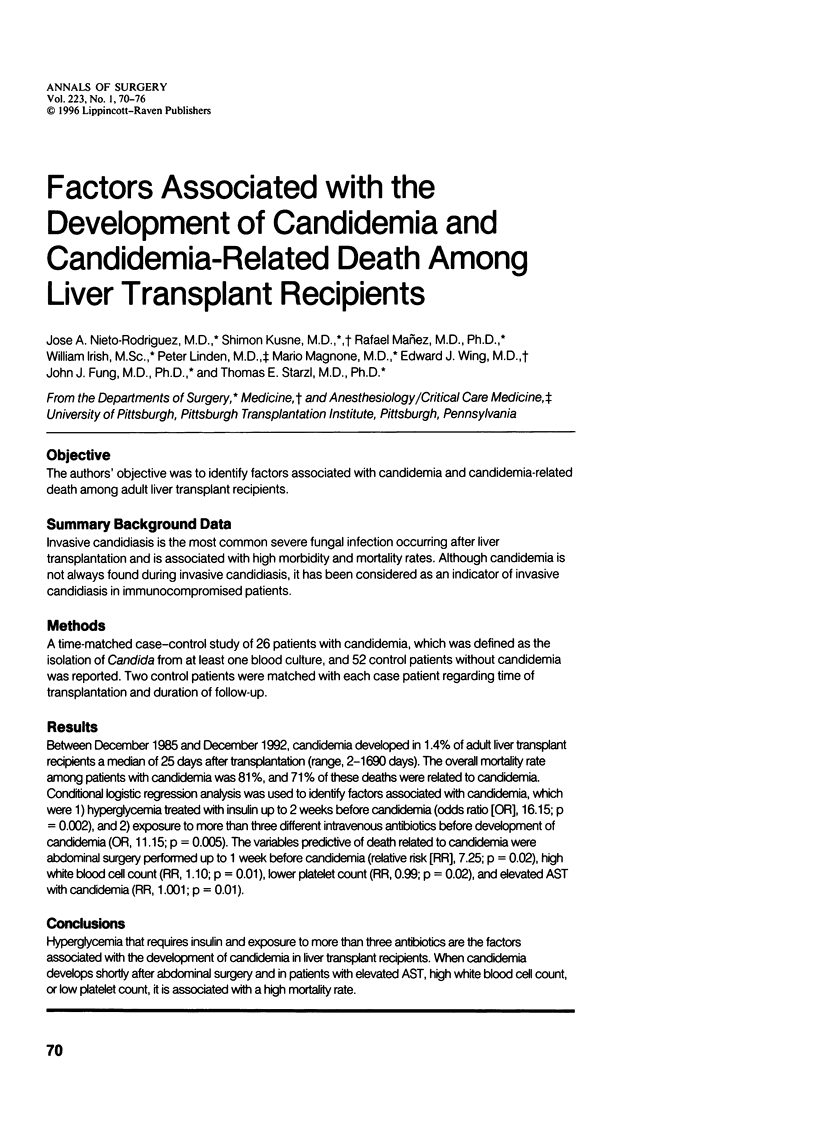
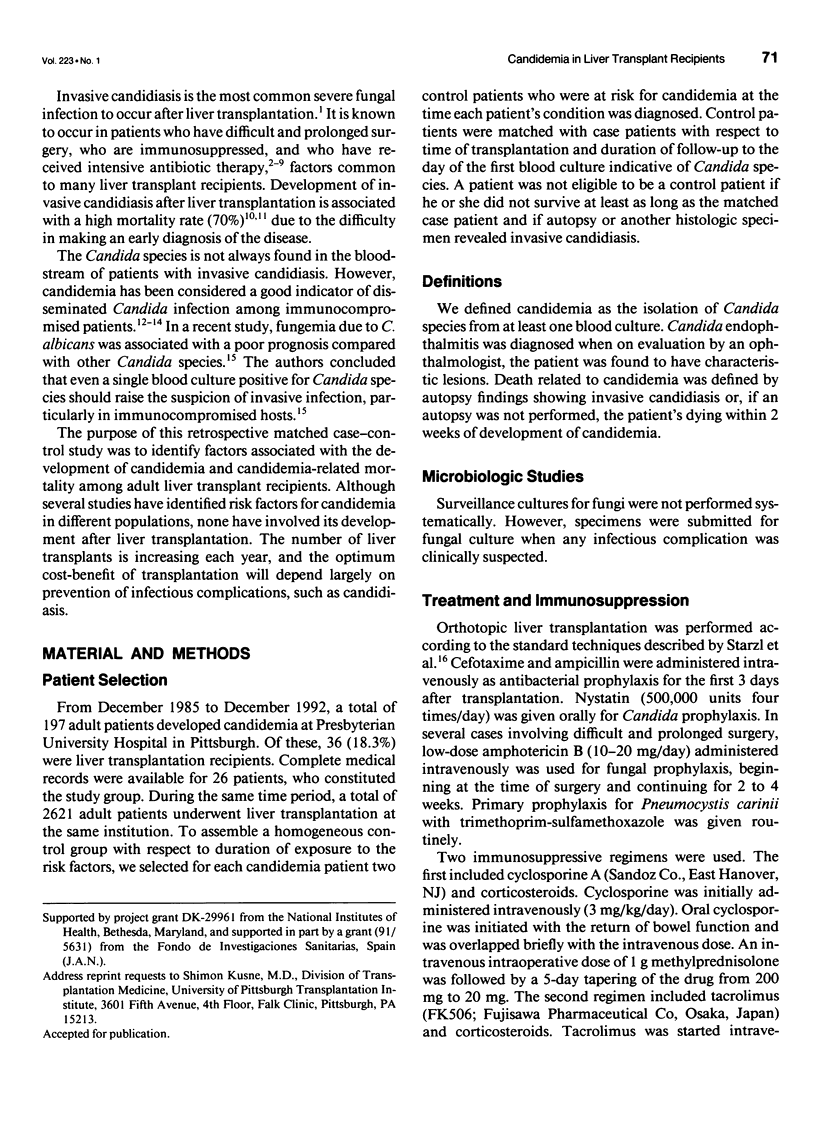

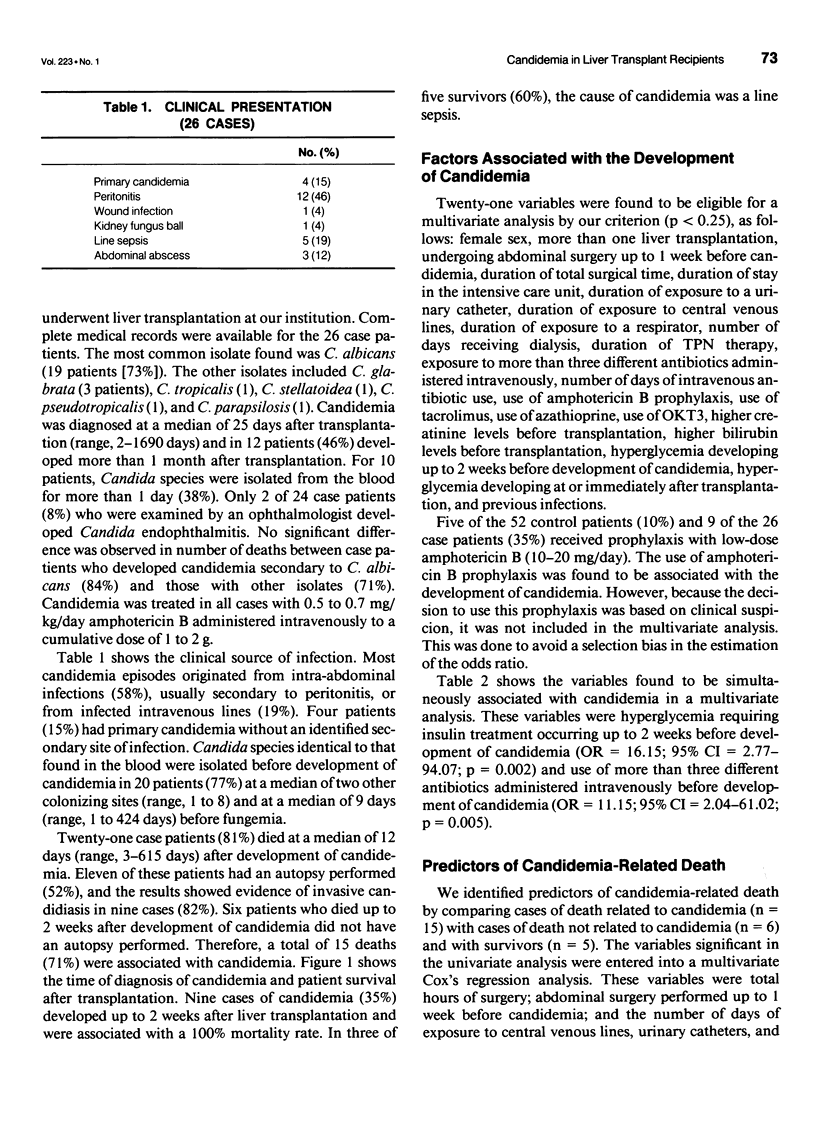

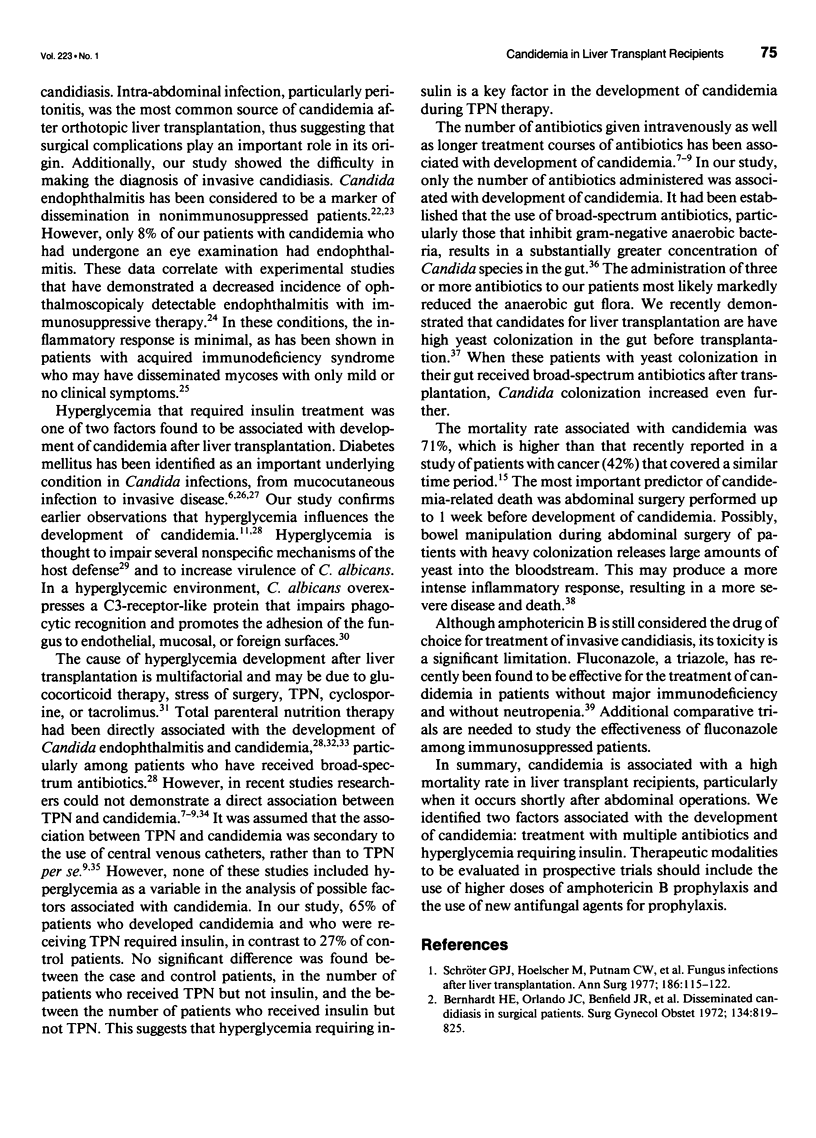
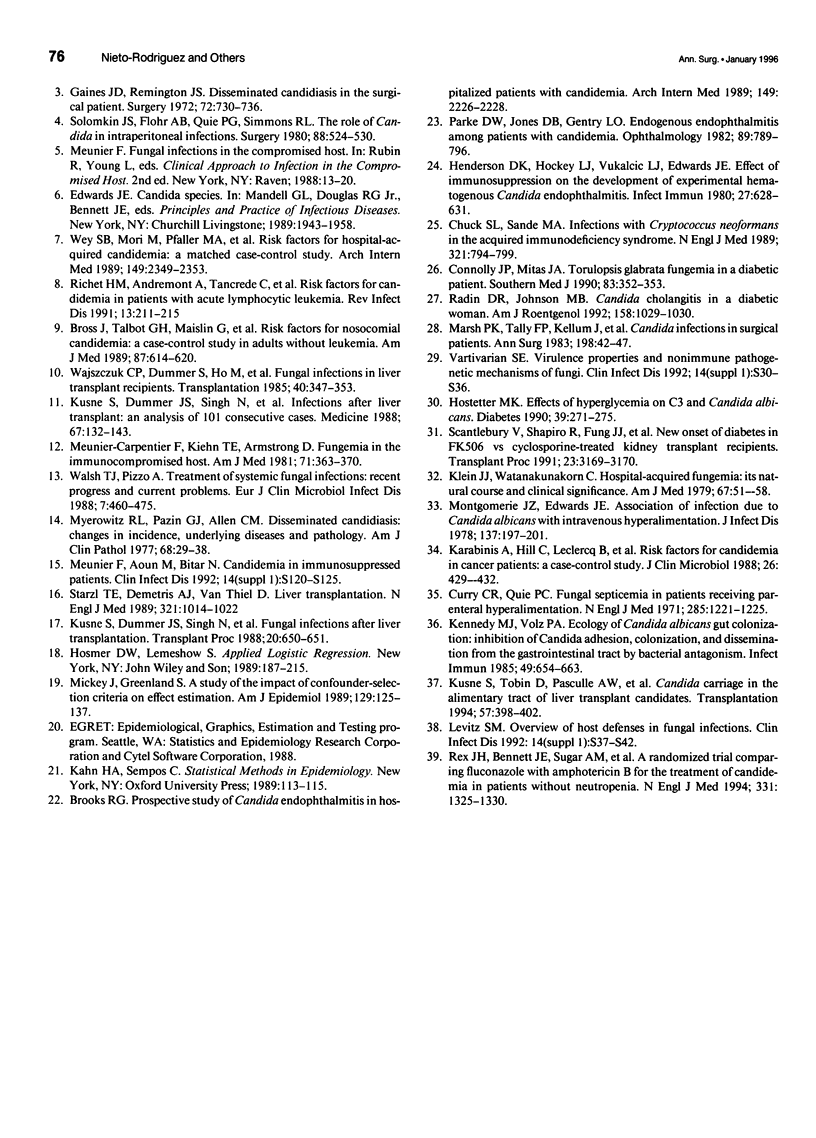
Selected References
These references are in PubMed. This may not be the complete list of references from this article.
- Bernhardt H. E., Orlando J. C., Benfield J. R., Hirose F. M., Foos R. Y. Disseminated candidiasis in surgical patients. Surg Gynecol Obstet. 1972 May;134(5):819–825. [PubMed] [Google Scholar]
- Brooks R. G. Prospective study of Candida endophthalmitis in hospitalized patients with candidemia. Arch Intern Med. 1989 Oct;149(10):2226–2228. [PubMed] [Google Scholar]
- Bross J., Talbot G. H., Maislin G., Hurwitz S., Strom B. L. Risk factors for nosocomial candidemia: a case-control study in adults without leukemia. Am J Med. 1989 Dec;87(6):614–620. doi: 10.1016/s0002-9343(89)80392-4. [DOI] [PubMed] [Google Scholar]
- Chuck S. L., Sande M. A. Infections with Cryptococcus neoformans in the acquired immunodeficiency syndrome. N Engl J Med. 1989 Sep 21;321(12):794–799. doi: 10.1056/NEJM198909213211205. [DOI] [PubMed] [Google Scholar]
- Connolly J. P., Mitas J. A., 2nd Torulopsis glabrata fungemia in a diabetic patient. South Med J. 1990 Mar;83(3):352–353. doi: 10.1097/00007611-199003000-00028. [DOI] [PubMed] [Google Scholar]
- Curry C. R., Quie P. G. Fungal septicemia in patients receiving parenteral hyperalimentation. N Engl J Med. 1971 Nov;285(22):1221–1225. doi: 10.1056/NEJM197111252852203. [DOI] [PubMed] [Google Scholar]
- Gaines J. D., Remington J. S. Disseminated candidiasis in the surgical patient. Surgery. 1972 Nov;72(5):730–736. [PubMed] [Google Scholar]
- Henderson D. K., Hockey L. J., Vukalcic L. J., Edwards J. E., Jr Effect of immunosuppression on the development of experimental hematogenous Candida endophthalmitis. Infect Immun. 1980 Feb;27(2):628–631. doi: 10.1128/iai.27.2.628-631.1980. [DOI] [PMC free article] [PubMed] [Google Scholar]
- Hostetter M. K. Handicaps to host defense. Effects of hyperglycemia on C3 and Candida albicans. Diabetes. 1990 Mar;39(3):271–275. doi: 10.2337/diab.39.3.271. [DOI] [PubMed] [Google Scholar]
- Karabinis A., Hill C., Leclercq B., Tancrède C., Baume D., Andremont A. Risk factors for candidemia in cancer patients: a case-control study. J Clin Microbiol. 1988 Mar;26(3):429–432. doi: 10.1128/jcm.26.3.429-432.1988. [DOI] [PMC free article] [PubMed] [Google Scholar]
- Kennedy M. J., Volz P. A. Ecology of Candida albicans gut colonization: inhibition of Candida adhesion, colonization, and dissemination from the gastrointestinal tract by bacterial antagonism. Infect Immun. 1985 Sep;49(3):654–663. doi: 10.1128/iai.49.3.654-663.1985. [DOI] [PMC free article] [PubMed] [Google Scholar]
- Klein J. J., Watanakunakorn C. Hospital-acquired fungemia. Its natural course and clinical significance. Am J Med. 1979 Jul;67(1):51–58. doi: 10.1016/0002-9343(79)90073-1. [DOI] [PubMed] [Google Scholar]
- Kusne S., Dummer J. S., Singh N., Iwatsuki S., Makowka L., Esquivel C., Tzakis A. G., Starzl T. E., Ho M. Infections after liver transplantation. An analysis of 101 consecutive cases. Medicine (Baltimore) 1988 Mar;67(2):132–143. doi: 10.1097/00005792-198803000-00006. [DOI] [PMC free article] [PubMed] [Google Scholar]
- Kusne S., Tobin D., Pasculle A. W., Van Thiel D. H., Ho M., Starzl T. E. Candida carriage in the alimentary tract of liver transplant candidates. Transplantation. 1994 Feb;57(3):398–402. doi: 10.1097/00007890-199402150-00014. [DOI] [PMC free article] [PubMed] [Google Scholar]
- Levitz S. M. Overview of host defenses in fungal infections. Clin Infect Dis. 1992 Mar;14 (Suppl 1):S37–S42. doi: 10.1093/clinids/14.supplement_1.s37. [DOI] [PubMed] [Google Scholar]
- Marsh P. K., Tally F. P., Kellum J., Callow A., Gorbach S. L. Candida infections in surgical patients. Ann Surg. 1983 Jul;198(1):42–47. doi: 10.1097/00000658-198307000-00008. [DOI] [PMC free article] [PubMed] [Google Scholar]
- Meunier-Carpentier F., Kiehn T. E., Armstrong D. Fungemia in the immunocompromised host. Changing patterns, antigenemia, high mortality. Am J Med. 1981 Sep;71(3):363–370. doi: 10.1016/0002-9343(81)90162-5. [DOI] [PubMed] [Google Scholar]
- Mickey R. M., Greenland S. The impact of confounder selection criteria on effect estimation. Am J Epidemiol. 1989 Jan;129(1):125–137. doi: 10.1093/oxfordjournals.aje.a115101. [DOI] [PubMed] [Google Scholar]
- Montgomerie J. Z., Edwards J. E., Jr Association of infection due to Candida albicans with intravenous hyperalimentation. J Infect Dis. 1978 Feb;137(2):197–201. doi: 10.1093/infdis/137.2.197. [DOI] [PubMed] [Google Scholar]
- Myerowitz R. L., Pazin G. J., Allen C. M. Disseminated candidiasis. Changes in incidence, underlying diseases, and pathology. Am J Clin Pathol. 1977 Jul;68(1):29–38. doi: 10.1093/ajcp/68.1.29. [DOI] [PubMed] [Google Scholar]
- Parke D. W., 2nd, Jones D. B., Gentry L. O. Endogenous endophthalmitis among patients with candidemia. Ophthalmology. 1982 Jul;89(7):789–796. doi: 10.1016/s0161-6420(82)34722-3. [DOI] [PubMed] [Google Scholar]
- Radin D. R., Johnson M. B. Candida cholangitis in a diabetic woman. AJR Am J Roentgenol. 1992 May;158(5):1029–1030. doi: 10.2214/ajr.158.5.1566661. [DOI] [PubMed] [Google Scholar]
- Rex J. H., Bennett J. E., Sugar A. M., Pappas P. G., van der Horst C. M., Edwards J. E., Washburn R. G., Scheld W. M., Karchmer A. W., Dine A. P. A randomized trial comparing fluconazole with amphotericin B for the treatment of candidemia in patients without neutropenia. Candidemia Study Group and the National Institute. N Engl J Med. 1994 Nov 17;331(20):1325–1330. doi: 10.1056/NEJM199411173312001. [DOI] [PubMed] [Google Scholar]
- Richet H. M., Andremont A., Tancrede C., Pico J. L., Jarvis W. R. Risk factors for candidemia in patients with acute lymphocytic leukemia. Rev Infect Dis. 1991 Mar-Apr;13(2):211–215. doi: 10.1093/clinids/13.2.211. [DOI] [PubMed] [Google Scholar]
- Scantlebury V., Shapiro R., Fung J., Tzakis A., McCauley J., Jordan M., Jensen C., Hakala T., Simmons R., Starzl T. E. New onset of diabetes in FK 506 vs cyclosporine-treated kidney transplant recipients. Transplant Proc. 1991 Dec;23(6):3169–3170. [PMC free article] [PubMed] [Google Scholar]
- Schröter G. P., Hoelscher M., Putnam C. W., Porter K. A., Starzl T. E. Fungus infections after liver transplantation. Ann Surg. 1977 Jul;186(1):115–122. doi: 10.1097/00000658-197707000-00017. [DOI] [PMC free article] [PubMed] [Google Scholar]
- Solomkin J. S., Flohr A. B., Quie P. G., Simmons R. L. The role of Candida in intraperitoneal infections. Surgery. 1980 Oct;88(4):524–530. [PubMed] [Google Scholar]
- Starzl T. E., Demetris A. J., Van Thiel D. Liver transplantation (1). N Engl J Med. 1989 Oct 12;321(15):1014–1022. doi: 10.1056/NEJM198910123211505. [DOI] [PMC free article] [PubMed] [Google Scholar]
- Vartivarian S. E. Virulence properties and nonimmune pathogenetic mechanisms of fungi. Clin Infect Dis. 1992 Mar;14 (Suppl 1):S30–S36. doi: 10.1093/clinids/14.supplement_1.s30. [DOI] [PubMed] [Google Scholar]
- Wajszczuk C. P., Dummer J. S., Ho M., Van Thiel D. H., Starzl T. E., Iwatsuki S., Shaw B., Jr Fungal infections in liver transplant recipients. Transplantation. 1985 Oct;40(4):347–353. doi: 10.1097/00007890-198510000-00002. [DOI] [PMC free article] [PubMed] [Google Scholar]
- Walsh T. J., Pizzo A. Treatment of systemic fungal infections: recent progress and current problems. Eur J Clin Microbiol Infect Dis. 1988 Aug;7(4):460–475. doi: 10.1007/BF01962595. [DOI] [PubMed] [Google Scholar]
- Wey S. B., Mori M., Pfaller M. A., Woolson R. F., Wenzel R. P. Risk factors for hospital-acquired candidemia. A matched case-control study. Arch Intern Med. 1989 Oct;149(10):2349–2353. [PubMed] [Google Scholar]


